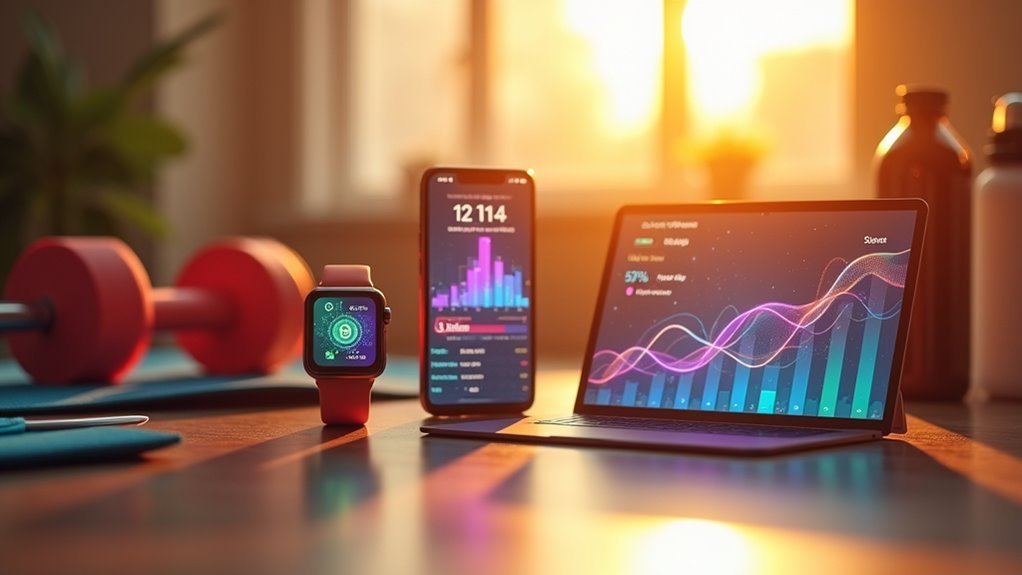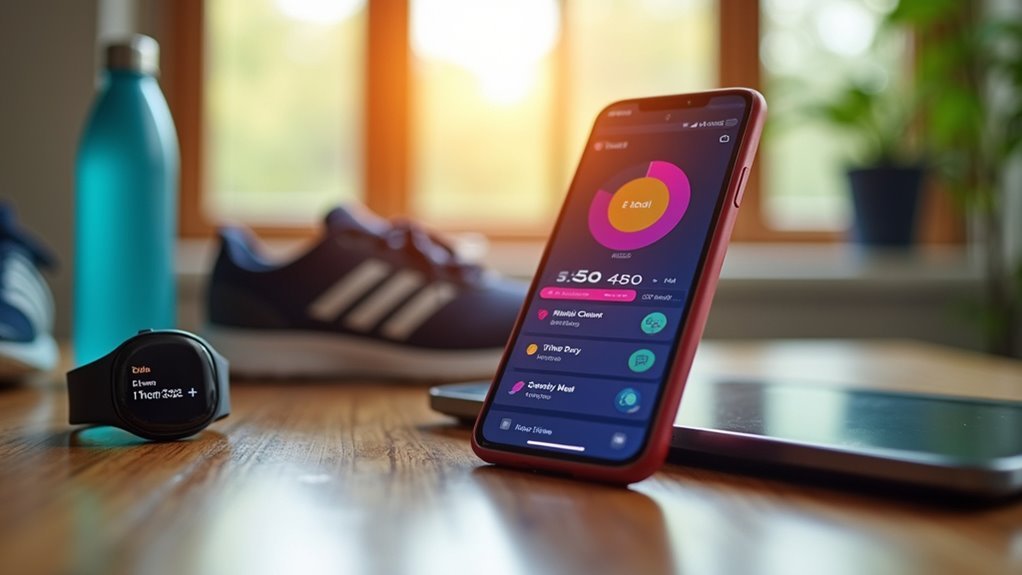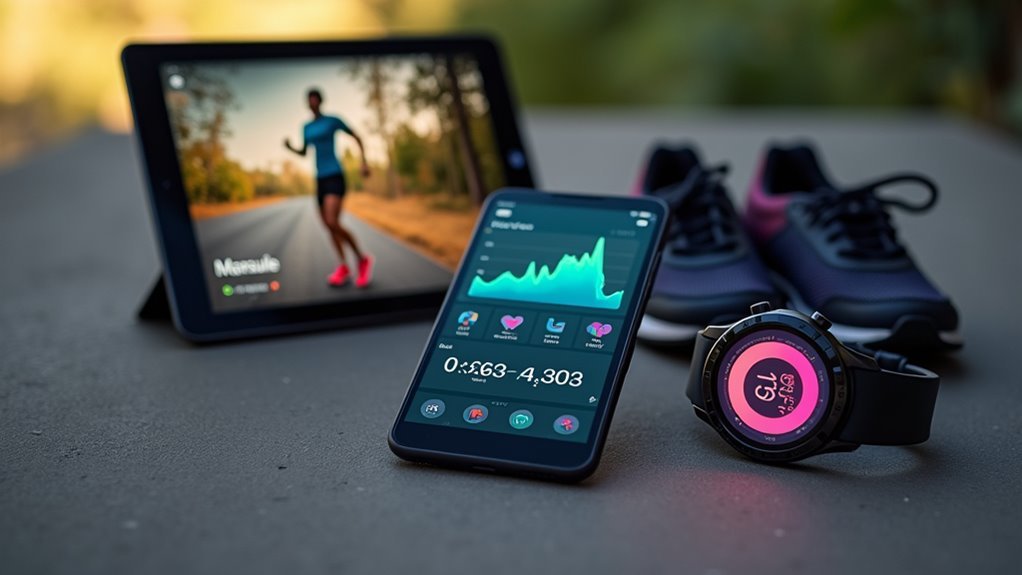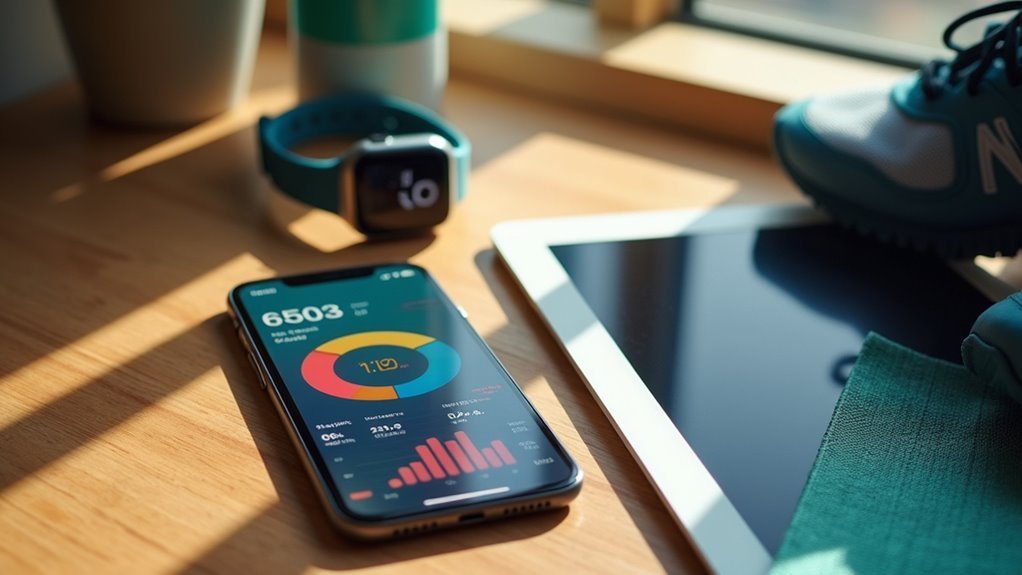You should connect your fitness apps across devices because it creates a thorough health profile that reveals patterns individual apps can’t show. Connected data improves accuracy through cross-verification, enables personalized workout recommendations, and reduces manual entry while ensuring continuity. This unified approach transforms fragmented metrics into meaningful insights about sleep quality, workout intensity, and recovery connections. With the fitness app market projected to reach $26.48 billion by 2032, understanding proper synchronization will open up your complete wellness potential.
Benefits of Unifying Your Fitness Data Across Multiple Devices

When you connect your fitness apps across multiple devices, you’ll gain a thorough view of your health that no single device can provide.
You’ll spot patterns and trends that isolated device data simply can’t reveal, giving you deeper insights into your overall fitness status. Cross-device synchronization lets you track progress consistently, even when switching or upgrading devices.
Your unified data enables personalized workout recommendations and recovery plans based on combined performance signals.
Combined fitness data from multiple devices creates smarter, more effective workout plans tailored specifically to your body’s unique signals.
You’ll receive tailored nutrition coaching and sleep improvement guidance. Real-time monitoring helps identify early warning signs of overtraining or injury risk.
Plus, you’ll eliminate manual data entry while maintaining seamless continuity across smartwatches, heart rate monitors, and gym equipment. Data visualization tools provide customizable graphs and analytics that transform your raw fitness information into actionable insights for better decision-making.
Multiple data sources also improve accuracy by cross-verifying readings and correcting device-specific biases.
Understanding How Fitness App Data Synchronization Actually Works
Behind the scenes of your seamless fitness tracking experience lies a complex network of data transfers orchestrated by APIs and cloud services. When you sync your fitness data, apps communicate through authorized APIs like Apple’s HealthKit or Android’s Health Connect, transferring information from your wearable to centralized platforms.
You’ll encounter different synchronization methods depending on your setup. Manual sync requires you to initiate transfers through app buttons, while automatic sync runs in the background at regular intervals. Your data moves in batches—activity metrics, heart rate, steps, and sleep patterns flow from source devices to destination apps.
However, you might face challenges like rate-limited API requests that slow historical syncs, permission changes requiring reauthorization, or platform exclusivity preventing cross-ecosystem transfers between iOS and Android devices. Not all workout apps are compatible with your device’s native fitness ecosystem, which can create gaps in your consolidated health data tracking.
Essential Features to Look for in Connected Fitness Applications

While understanding data synchronization helps you grasp how fitness apps communicate, selecting the right connected fitness application requires evaluating specific features that’ll maximize your health tracking experience.
You’ll want seamless multi-device synchronization across smartphones, tablets, and wearables like Fitbit or Apple Watch. Look for real-time tracking of steps, heart rate, and calories with offline capability that syncs when you’re back online.
Essential features include customizable workout routines, AI-powered coaching that adapts to your performance, and thorough nutrition management. Gamification elements like badges boost motivation, while push notifications encourage consistency.
AI-powered coaching and gamification features transform routine workouts into personalized, engaging fitness experiences that adapt to your progress.
Prioritize apps with intuitive dashboards, secure data handling, geolocation tracking for outdoor activities, and integration with gym equipment to create a complete fitness ecosystem. Additionally, ensure the app offers video tutorials that demonstrate proper exercise techniques to reduce injury risk and improve workout effectiveness.
Why Device Interoperability Matters More Than Ever in Fitness Tracking
You’re probably collecting fitness data from multiple devices right now, but if they can’t communicate with each other, you’re missing essential connections in your health story.
When your smartwatch, fitness app, and smart scale work together seamlessly, you’ll gain deeper insights that individual devices simply can’t provide on their own. With over 35,000 medical apps available on major app stores as of 2024, the ecosystem for comprehensive health tracking has never been more robust.
This cross-platform integration transforms scattered data points into actionable health intelligence that actually helps you reach your goals.
Fragmented Data Creates Gaps
When you switch between your smartwatch, fitness app, and gym equipment throughout the day, you’re likely creating a scattered trail of health data that doesn’t tell your full fitness story.
This fragmentation creates serious gaps that undermine your progress tracking and health insights.
Without integrated data, you’ll miss thorough analysis of your overall fitness journey. Your morning run data from one app won’t sync with afternoon strength training from another device, leaving you with incomplete metrics that can’t provide meaningful trends or patterns.
This inconsistency affects accuracy and creates frustration that often leads users to abandon their fitness apps entirely. With users spending only four minutes daily on average with health and fitness apps, maximizing the value of that brief engagement becomes crucial for maintaining long-term commitment.
You’re left questioning which numbers to trust when different devices show conflicting information, eroding confidence in your health tracking system.
Seamless Cross-Platform Integration
Device interoperability transforms the frustrating experience of fragmented fitness data into a unified health ecosystem that actually works for you.
When your fitness apps communicate seamlessly across devices, you’ll access consistent data whether you’re using your smartphone, tablet, or smartwatch. This eliminates the confusion of having different step counts or workout stats on different platforms.
Your wearables become powerful allies, providing real-time heart rate monitoring and instant feedback that enhances workout effectiveness.
You’ll receive personalized insights based on extensive data collection, while automatic synchronization guarantees your progress follows you everywhere. Security protocols protect your personal information during these data transfers between devices.
This consistency builds trust in your fitness tracking system, keeping you motivated through accurate statistics and community features that let you compete with friends across any device platform.
Enhanced Health Insights
Connected fitness ecosystems reveal powerful health insights that go far beyond basic step counting or calorie tracking.
When you sync data across multiple devices and platforms, you’re creating an all-encompassing health profile that delivers actionable intelligence about your body’s patterns and performance.
This interoperability transforms fragmented data points into meaningful health narratives. You’ll discover connections between sleep quality, workout intensity, and recovery times that single-device tracking simply can’t provide.
The aggregated data enables early detection of potential health issues and supports informed decision-making about your wellness journey. With 75% of healthcare providers now utilizing wearable data for patient monitoring, this comprehensive approach significantly reduces the need for frequent doctor visits while helping medical professionals adjust treatment plans more effectively.
Key benefits of connected health data include:
- Thorough monitoring across all health metrics simultaneously
- Personalized recommendations based on your complete activity profile
- Advanced pattern recognition identifying trends invisible to isolated apps
Current Market Trends Fueling Connected Fitness App Adoption
You’re witnessing an unprecedented surge in the connected fitness market, with app revenue alone projected to exceed $10 billion by 2025.
This explosive growth isn’t happening in isolation—it’s being driven by the rapid expansion of wearables and IoT devices that seamlessly integrate with fitness applications. The fitness app industry has already demonstrated remarkable momentum, with revenue increasing 11.1% in 2024 to reach $3.98 billion despite declining usage patterns.
As these technologies converge, you’ll find yourself at the center of a fitness ecosystem that’s becoming more interconnected and data-rich than ever before.
Rapid Market Growth Projections
The fitness app industry is experiencing unprecedented expansion, with global revenue reaching $3.98 billion in 2024—an impressive 11.1% jump from the previous year.
You’re witnessing a market transformation that’ll reshape how fitness technology integrates across your devices.
The numbers paint a compelling picture for connected fitness solutions:
- U.S. market explosion: From $568 million in 2024 to a projected $1.96 billion by 2033 (14.8% CAGR)
- Global acceleration: Expected growth of $101.60 billion between 2024-2029 at 24.2% CAGR
- Total market surge: Sports and fitness apps jumping from $10.32 billion in 2025 to $26.48 billion by 2032
This rapid expansion creates opportunities for seamless device connectivity.
As you consider connecting your fitness apps, you’re positioning yourself within a market that’s prioritizing integration and cross-platform functionality to deliver thorough health experiences. The surge is driven by over 100 million users engaging with fitness apps daily worldwide, creating massive demand for interconnected fitness ecosystems.
Wearables and IoT Expansion
As wearable technology claims the top fitness trend spot for 2025, it’s driving unprecedented integration opportunities with your fitness apps.
Your wearables now collect advanced data beyond basic heart rate—tracking muscle tiredness, hydration levels, and mental health metrics. This granular information syncs seamlessly with your apps, delivering actionable insights for personalized fitness plans.
Enhanced connectivity guarantees real-time data exchange between your devices, while advanced sensors provide continuous monitoring that adjusts your routines instantly.
You’ll benefit from AI-powered predictions and data-driven training methods that create highly tailored experiences. With 850 million downloads reflecting the explosive growth of mobile exercise apps, the infrastructure for seamless device connectivity continues expanding rapidly.
Real-World Applications for Multi-Device Fitness Data Integration

How can multi-device fitness data integration transform your daily health and wellness routine? When your smartwatch, smartphone, and gym equipment work together seamlessly, you’ll experience a thorough approach to health monitoring that goes far beyond basic step counting.
Your synchronized devices create a powerful ecosystem that supports three key real-world applications:
Your synchronized devices create a powerful ecosystem that transforms fragmented health data into actionable insights for comprehensive wellness.
- Professional healthcare monitoring – Your doctor can access continuous health data for proactive medical interventions and personalized treatment plans.
- Adaptive training programs – Fitness apps automatically adjust your workouts based on real-time performance data from multiple sources.
- Thorough wellness tracking – Combined sleep, activity, and biometric data reveals health patterns you’d otherwise miss.
This integration eliminates manual data entry while providing accurate, actionable insights that enhance your fitness journey and overall well-being. With 127 new devices connecting to the Internet every second, the opportunities for seamless fitness data integration continue expanding rapidly.
Step-by-Step Guide to Connecting Your Fitness Apps and Devices
Successfully connecting your fitness apps and devices requires a systematic approach that guarantees seamless data flow between all your health monitoring tools.
Start by identifying compatible apps like Apple Health, Google Fit, or Strava that support integration capabilities. Check official support documents to confirm cross-platform compatibility and review user ratings for reliability feedback.
Next, open each fitness app and grant necessary permissions through health data sharing screens. Navigate to device connection menus and follow prompts to authorize third-party access. Many fitness devices utilize Bluetooth Low Energy technology, which provides power-efficient communication and can maintain battery life for extended periods.
Locate connection options within your apps, select your device from supported lists, and enter credentials when prompted for authentication.
After successful pairing, monitor your activity dashboard to verify incoming data. Schedule regular syncs and adjust privacy settings to control visible metrics for ideal performance.
Overcoming Common Challenges in Fitness App Synchronization
While setting up fitness app connections may seem straightforward, you’ll likely encounter several technical hurdles that can disrupt your data synchronization. Each device manufacturer uses proprietary systems that don’t communicate well with competitors, creating compatibility gaps that affect your workout tracking.
When sync issues occur, you’ll notice missing data or duplicate entries that throw off your progress analytics. Here’s how to tackle the most common problems:
- Check API connections regularly – Many third-party integrations break when apps update.
- Verify data field mappings – Confirm heart rate, distance, and calories transfer correctly between platforms.
- Monitor authentication status – Re-login when sync delays exceed normal timeframes.
You’ll need patience as background processes can take several minutes to complete. Keep detailed logs of any persistent errors to help troubleshoot recurring synchronization failures effectively. The absence of universal compatibility standards among fitness app developers continues to create these ongoing integration challenges across different platforms.
Maximizing Your Health Insights Through Connected Fitness Ecosystems
Once you’ve resolved synchronization issues and established reliable data flow between your devices, you can access the true power of connected fitness ecosystems.
Your synchronized apps now provide thorough biometric data analysis, tracking heart rate, sleep patterns, and other essential health metrics that help detect potential issues early.
AI-driven insights analyze this data to offer personalized workout recommendations and health advice tailored specifically to you. You’ll receive real-time feedback after each workout, enhancing your understanding of performance and progress.
The holistic health monitoring from your wearables and connected equipment creates a complete picture of your fitness journey. Open ecosystems allow syncing of various connected fitness devices to ensure seamless data integration across all your platforms.
Most importantly, continuous long-term health tracking lets you observe trends and improvements over time, transforming scattered data points into actionable health insights.
Frequently Asked Questions
Does Connecting Fitness Apps Drain My Phone Battery Faster?
Yes, connecting fitness apps drains your battery faster. You’re enabling constant background processes, GPS tracking, data syncing between devices, and Bluetooth connections. These features run continuously, consuming significant power even when you’re not actively using the apps.
Can I Still Use Fitness Apps Offline After Connecting Them?
Yes, you can still use fitness apps offline after connecting them. Your workouts and tracking continue without internet, storing data locally on your device until connectivity returns for automatic syncing.
What Happens to My Data if I Switch Phones?
Your fitness data transfers smoothly between iPhones using iCloud backup, but you’ll need encrypted backups for complete health information. Without proper migration, you’ll lose historical activity logs permanently.
Are There Monthly Fees for Connecting Multiple Fitness Apps?
You won’t pay extra fees for connecting multiple fitness apps. However, each app charges its own monthly subscription – typically $10-13/month per app. You’ll need separate subscriptions for each service you use.
How Do I Disconnect Apps if I No Longer Want Them Synced?
You’ll need to access your fitness app’s settings and find “Connected Apps” or “Manage Access.” Select the app you want to disconnect, then choose “Revoke Access” or “Disconnect” to stop syncing.
In Summary
You’ll transform your fitness journey by connecting apps across devices, gaining extensive health insights you can’t achieve with isolated tracking. You’re no longer limited to single-device data when you embrace synchronization – you’ll see patterns, trends, and progress that drive real results. Don’t let technical challenges discourage you from building your connected fitness ecosystem. Start with one integration today, and you’ll quickly discover how unified data becomes your most powerful wellness tool.





Leave a Reply